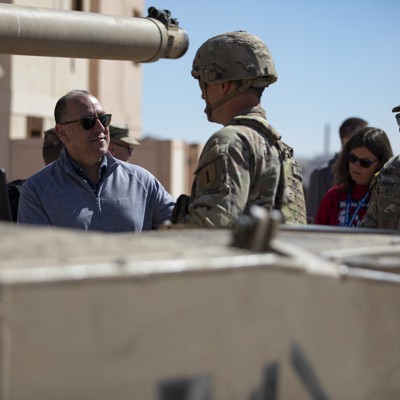After years of smaller experiments, the Army is rolling out its broad vision for digital engineering—and preparing to try it on some of its biggest programs.
“Historically, the Army has relied on traditional systems engineering processes, which are largely manual, document-intensive, and…can often drive cost and development timelines, hindering the Army from delivering cutting-edge capabilities at pace,” Army Undersecretary Gabe Camarillo wrote in the policy memo released Tuesday.
All that should change under digital engineering, which aims to replace pen-and-paper designs with computer-based ones, promising faster design, cheaper simulation, easier changes, smoother upgrades, better maintenance, and more.
One aspect is the creation of digital twins: precise virtual models “of a system as it matures over time,” the memo says.
The memo says the Army will start its broad move toward digital engineering in the areas of ground vehicles, aviation, and sensors. It designates six programs as initial testbeds: the XM-30 Mechanized Infantry Combat Vehicle; Future Long-Range Assault Aircraft; Integrated Fires Mission Command; Joint Targeting Integrated Command and Control Suite; Program Executive Office Aviation Logistics Data Analysis Lab (Black Hawk, Apache, Chinook); and the M113 Armored Personnel Carrier, which has digital twins that “apply broadly to the ground vehicle fleet.”
The Army has been teasing its digital engineering policy since last year, but has been slow to follow suit of other military branches in the area. The Pentagon released an overarching digital engineering policy in December.
“The reality is, we’re a little bit late adopters in terms of the technology that industry is using for digital engineering ecosystems,” Camarillo said last year at the Army’s annual conference. “So this policy is designed to take, kind of, the next big step towards more widespread adoption in the Army.”
Read the full article here



:quality(70)/cloudfront-us-east-1.images.arcpublishing.com/archetype/L7J77CMOA5AT7EQPFKFKHH474Y.jpg)
:quality(70)/cloudfront-us-east-1.images.arcpublishing.com/archetype/TWXAWVZ3MZCG5HTEQ5AXCSYN4I.JPG)
:quality(70)/cloudfront-us-east-1.images.arcpublishing.com/archetype/T4SU6FOBXJBDVDEIE2CV2QJMFY.jpg)
:quality(70)/cloudfront-us-east-1.images.arcpublishing.com/archetype/6GNCPHURV5HZLIKLFVDVWZJHCQ.jpg)
Leave a Reply